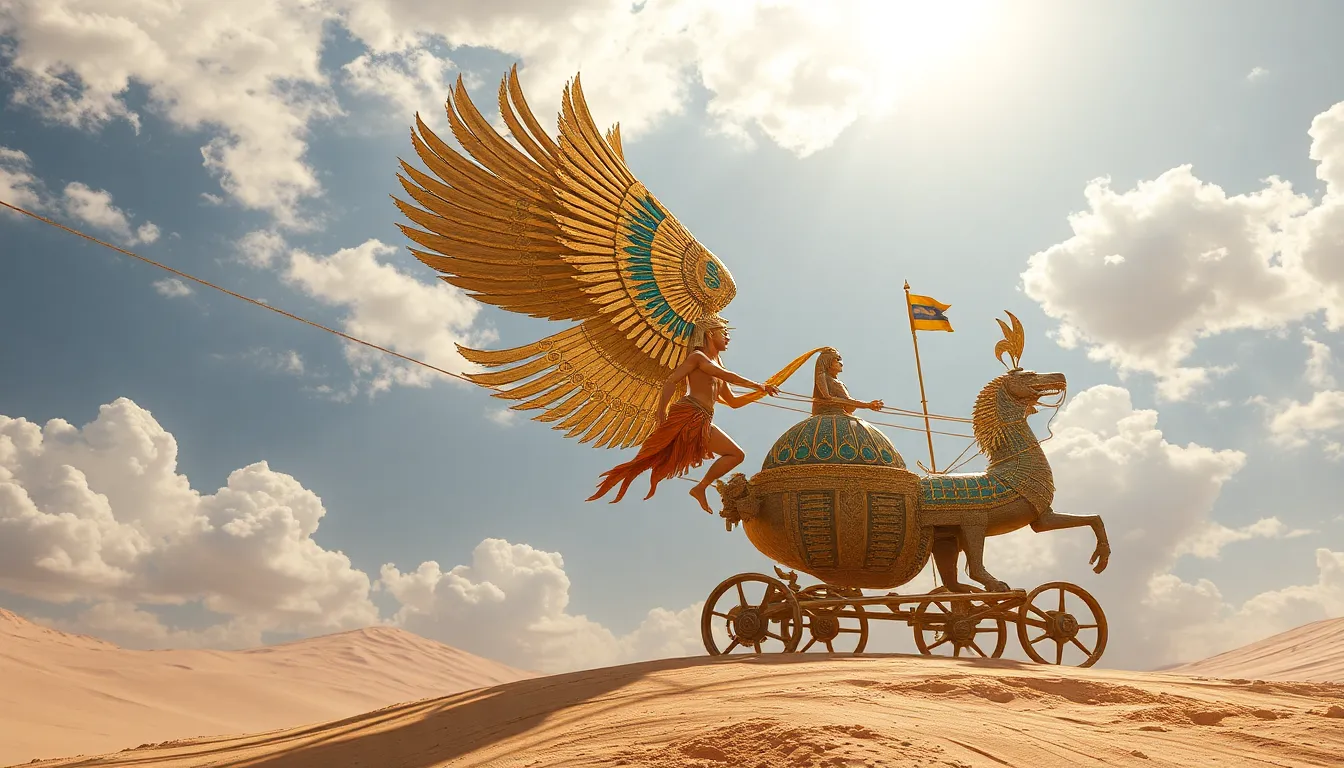The Myth of the Celestial Chariot: Ra’s Journey Across the Sky
Introduction to Ra and Egyptian Mythology
In the pantheon of ancient Egyptian deities, Ra stands out as one of the most significant gods. Often revered as the god of the sun, Ra embodies the life-giving power of the sun and is associated with creation and order. Egyptians viewed Ra as the ruler of the heavens, a symbol of light, and a harbinger of life. His importance is reflected in various aspects of Egyptian culture, from religion to daily life.
The sun held profound significance in Egyptian mythology. It was not merely a celestial body but a vital force that influenced the rhythms of life. The daily cycle of day and night was interpreted as a cosmic battle between light and darkness, with Ra as the champion of light, battling against chaos and the forces of the underworld. This duality is central to understanding Ra’s myth and his celestial chariot.
The Concept of the Celestial Chariot
Ra’s celestial chariot, a grand and radiant vehicle, is a central element of his mythology. It symbolizes his journey across the sky, illuminating the world below. Ancient texts and artwork often depict this chariot as a magnificent platform drawn by powerful horses, representing the sun as it rises and sets each day.
- Symbolic Meanings: The chariot is not only a means of transportation but also a representation of power, divinity, and the cyclical nature of life.
- Artistic Depictions: In various tomb paintings and reliefs, Ra is shown driving his chariot across the sky, with rays of sunlight emanating from him, blessing the earth.
Ra’s Journey Across the Sky
Ra’s daily journey is a fascinating tale that reflects the rhythms of nature. At dawn, he rises in the east, symbolizing rebirth and the triumph of light over darkness. As he traverses the sky, he passes through various realms and faces challenges that represent the struggles of life.
The journey can be broken down into key phases:
- Dawn: Ra begins his journey, emerging from the horizon, bringing light and warmth to the world.
- Noon: At the zenith of his journey, Ra is at his most powerful, pouring down blessings and vitality to the earth.
- Dusk: As the sun sets in the west, Ra’s light begins to fade, symbolizing the inevitable approach of darkness.
- Night: Ra descends into the underworld, where he continues his journey through the realm of the dead, battling the serpent Apophis, a representation of chaos.
Mythological Figures Associated with Ra
Ra’s journey is not a solitary endeavor; several deities accompany or assist him along the way. Key figures include:
- Sekhmet: The lioness goddess who represents the fierce and protective aspects of the sun, often seen as Ra’s daughter.
- Nut: The sky goddess who swallows Ra at night, only to give birth to him again at dawn, symbolizing the cycle of life and death.
- Horus: Often associated with kingship and the sky, Horus is sometimes depicted as Ra’s protector during his nightly journey.
Symbolism and Interpretation of Ra’s Journey
The journey of Ra across the sky is rich in symbolism. It represents the eternal struggle between light and darkness, order and chaos. This duality is reflected in various aspects of life:
- Light: Associated with knowledge, life, and creation.
- Darkness: Represents ignorance, death, and the unknown.
Philosophically, Ra’s journey can be interpreted as a metaphor for life, death, and rebirth. Each day brings the promise of renewal, while the night serves as a reminder of mortality and the importance of balance in the universe.
Cultural Impact of the Celestial Chariot Myth
Ra’s myth has had a profound influence on Egyptian art, architecture, and literature. Temples dedicated to Ra, such as the Temple of Karnak, feature elaborate carvings depicting his journey. Furthermore, the concept of the celestial chariot inspired various artistic representations, from wall paintings to sculptures.
In contemporary culture, Ra’s legacy continues to resonate. His symbolism can be found in:
- Literature that explores themes of light and darkness.
- Modern interpretations of Egyptian mythology in films and books.
- Spiritual discussions that delve into the meanings of life and death.
Debunking Misconceptions about Ra’s Journey
Despite the rich tapestry of Ra’s mythology, several misconceptions persist:
- Ra as a sole deity: Some believe Ra was the only god worshipped in ancient Egypt, while in reality, he was part of a complex pantheon.
- Linear journey: Many interpret Ra’s journey as a straightforward path, ignoring the mythological battles and challenges he faces.
Understanding the historical and cultural contexts of Ra’s myth helps clarify these misconceptions, revealing a more nuanced understanding of ancient Egyptian beliefs.
Conclusion: The Enduring Legacy of Ra’s Myth
In summary, Ra’s journey across the sky encapsulates the essence of ancient Egyptian mythology. It reflects the cyclical nature of life, the interplay of light and darkness, and the eternal struggle for order amidst chaos. Ra’s myth not only shaped the spiritual landscape of ancient Egypt but continues to be relevant in contemporary discussions about mythology and spirituality.
As we explore the enduring legacy of Ra, we recognize the timeless themes of rebirth, resilience, and the quest for understanding that resonate across cultures and eras.




